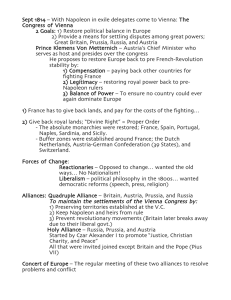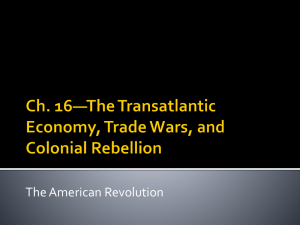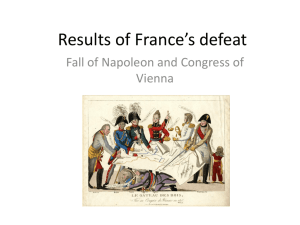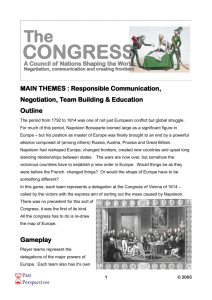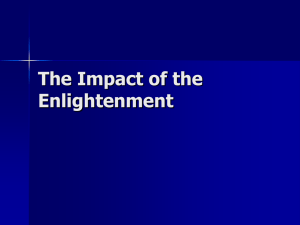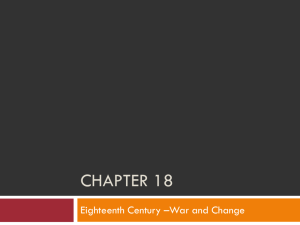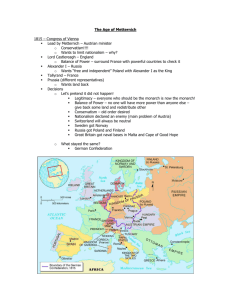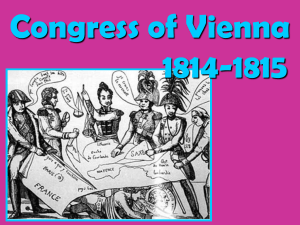The Congress of Vienna
advertisement
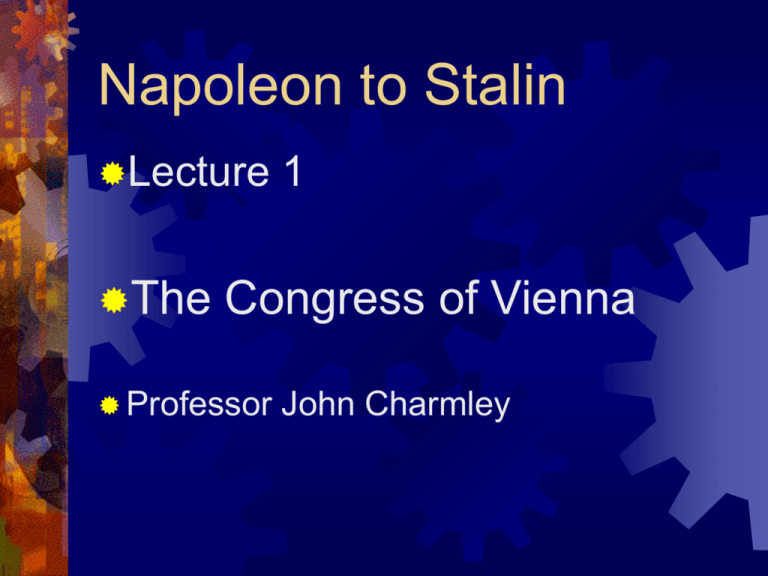
Napoleon to Stalin Lecture The 1 Congress of Vienna Professor John Charmley .The Architects I – Russia Clemens von Metternich – Austria Viscount Castlereagh – Britain Prince Talleyrand – France Frederick William III - Prussia Tsar Alexander Tsar Alexander I Ruled 1801-25 Allied with France 1807 Invaded by France 1812 ‘Mystic’ Prince Metternich 1773-1859 Born in Rhineland Ambassador to Napoleon 1806 Sponsored marriage to Marie-Louise Feared French reprisals 1812-13 Wanted security Viscount Castlereagh Anglo-Irish Foreign secretary 1812-22 Directed British policy Wanted balance of power Works with Metternich Prince Talleyrand Bishop of Autun ‘Vicar of Bray’ Concern for France Broke with Napoleon in 1807 Wants to preserve French power Desiderata : Russia Security through strength Land in Poland and south-east Europe Warm water ports Recognition ‘Holy Alliance’ –England is excluded Desiderata : Austria Security through a balance of power Stop French expansion Stop Prussian expansion Stop Russian expansion Stop liberalism & nationalism Swap Austrian Netherlands for northern Italy Desiderata : Britain Security through a balance of power Economic growth & colonies Security for the Low Countries French Power checked End of the Slave Trade Desiderata : Prussia Security Land in Germany Desiderata : France Damage Limitation Balance of Power Restoration of status To benefit from disputes within the Alliance Treaty of Kalisch, 28 Feb 1813 Russia and Prussia Russia to get most of Poland Prussia to get Saxony ‘Security through strength’ Ignored Austria and Britain Nearly caused war in January 1815 Reichenbach, 27 June 1813 Russia/Prussia/Austria Austria to join war against France Poland’s future to be decided ‘amicably’ No mention of Kalisch All Powers now joined against France Teplitz, 9 September 1813 Russia, Prussia, Austria Poland’s fate to be ‘settled amicably’ Status Quo 1805 for own territory Britain not included Frankfurt Proposals 9 Nov 1813 Devised by Metternich Generous to France France to have ‘natural frontiers’ Would have given frontier on Rhine Agreed to by Lord Aberdeen Prompted Castlereagh to Europe 18-22 Jan. 1814 Basel Conf. Metternich & Castelreagh Agree on definition of security Security through balance of power Netherlands recreated 24-28 Jan. 1814 Langres Conf Colonies kept out of negotiations Maritime rights kept out No British quid pro quo France to have ‘ancient limits’ Low Countries not French Chaumont, 9 March 1814 Britain, Russia, Austria, Prussia Alliance against France for 20 years German Confederation Swiss Independence Italy of separate states Spain ruled by Bourbon Holland ruled by House of Orange Balance of Power to be created Defects of Chaumont Did not include Poland Alexander could have had any terms at this point Britain had to promise generous subsidies to get expansion of Holland Kalisch not mentioned Cemented only by Napoleon Congress of Vienna Opened October 1814 3 territorial agreements 1st Treaty of Paris, 30 May 1814 Final Act, 9 June 1815 2nd Treaty of Paris, 20 Nov. 1815 Waterloo, 18 June 1815 Major Problems Who should rule France? The Place of France in Europe Poland and Saxony Balance of Power & security Who should rule France? Major differences in early 1814 Britain favoured Napoleon Austria favoured Marie-Louise Russia favoured Bernadotte Talleyrand suggested Louis XVIII Napoleon abdicated 6 April 1814 Louis XVIII enters Paris 3 May 1814 France’s Place in Europe The rights of smaller states The principle of legitimacy 3 January 1815 allied with Britain and Austria against Kalisch ‘France is no longer isolated in Europe’ 9 Jan. 1815 France included in Directing Committee Poland and Saxony (I) Saxony had stayed allied with France Prussians would give up Poland Russians would allow her Saxony In return for Russia getting Poland Austria and Britain disagreed Winter 1814/15 differences acute Poland and Saxony (II) Oct & Nov. Britain try to woo Prussia December Prussia declares any change in Kalisch will lead to war 3 Jan. 1815 France sides with Austria Alexander decides not to risk war Prussia gets part of Saxony Kingdom of Warsaw Balance of Power Issues Fate of France Fate of Austrian Netherlands Italian peninsular Germany Poland France’s fate (I) 1st Treaty of Paris May 1814 1793 frontiers Lost Nice & Savoy No Indemnity No Occupation No loot returned Colonies to GB Napoleon to Elba 2nd Treaty of Paris November 1815 1790 frontiers Lost Saarlouis etc. F700m+ indemnity Occupation 3-5 yrs Loot returned Colonies to GB Napoleon to St. Helena France’s fate (II) Talleyrand’s diplomacy brought an end to French isolation France tended to side with Austria/GB No feeling of ‘revanche’ Bourbon diplomacy v. cautious Italy : Austrian domination Lombardy & Venetia directly to Austria Parma: Marie Louise (daughter FI) Modena: Francis IV (cousin F I) Tuscany: Ferdinand III (bro. F I) Pope Pius VII allied to Austria Austria had right to garrison Ravenna, Bologna & Ferrara Italy : the rest Piedmont-Sardinia Given a buffer-zone Genoa Pope Pius VII ruled Rome, The Marches and the Romagna Ferdinand I restored after the 100 days to the Two Sicilies – linked by alliance to the Habsburgs Germany Pre-Napoleon +350 state(let)s Napoleonic Confederation of Rhine C of Rhine had been 16 states Chaumont decided on Confederation 38 States, led by Austria Federal Diet at Frankfurt Austrian Netherlands Added to Kingdom of Holland ‘Buffer’ zone against French expansion Made Netherlands middle-ranking Power Barrier fortresses against French invasion Poland ‘Congress Poland’ Prussia & Austria gave up large parts Prussia: Posen, retained Thorn Austria: reacquired Galicia Congress Poland ruled by Constantine Nominally Independent only Winners Austria: dominated Italy & Germany Russia: dominated Poland; had also gained Finland (1808) & Bessarabia (1812) Prussia: gained Rhineland, parts of Poland, 60% Saxony, Swedish Pomerania Britain: Low Countries secure; abolition of Slave trade Losers Nationalism Liberalism France? Nationalism Associated with Revolution Antithetical to dynastic rights Antithetical to Habsburgs Nationalism limited Educated middle-class groups Liberalism Not totally ignored Constitutions existed in: Finland, France, Netherlands, Norway, Poland & Sweden All linked to Monarchies All at whim of Monarch Britain most constitutional state – but had no written Constitution Quadruple & Holy Alliances Quadruple Alliance, 20 Nov. 1815 Britain, Russia, Austria, Prussia Holy Alliance, 26 Sept. 1815 Russia, Austria, Prussia Holy Alliance Tsar Alexander I’s idea ‘a loud sounding nothing’ (Metternich) ‘a piece of sublime mysticism and nonsense’ (Castlereagh) ‘members of one and the same Christian nation’ (Alexander I) Quadruple Alliance For 20 years against France Article VI ‘meetings at fixed periods’ Congresses: Aix-la-Chapelle (1818) Troppau (1820) Laibach (1821) Verona (1822) Problems for the future Quadruple or Holy? Intervene in internal affairs? Or only in foreign affairs? Problematic for British And for Metternich Europe in 1815 France confined Not humiliated Concert restored Compromise War-weariness Alliance for future
